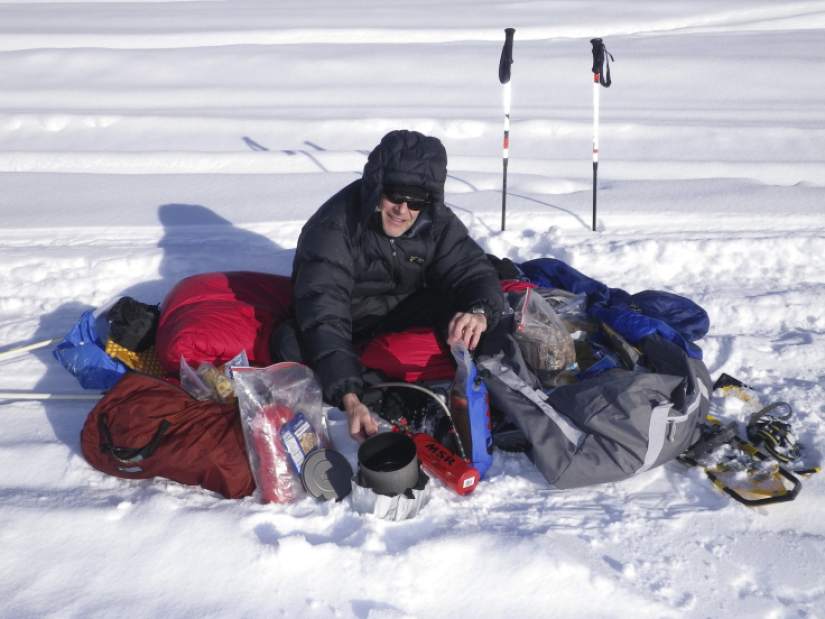Unity man captures Iditarod record
For 19 days, nine hours and 38 minutes last month, Latrobe attorney Tim Hewitt trudged across 1,000 miles of desolate Alaskan wilderness, defying nature on his way to capturing another record in the famed Iditarod Trail Invitational.
The 61-year-old pushed himself not only to be the first to finish on foot, but to set a record for the northern route in the grueling event that bills itself as the world's ultra winter marathon.
He started at 2 p.m. Feb. 28 and completed the journey on the afternoon of March 19. The race went from Knik, which is north of Anchorage, over the Alaska Range and into Nome, just 140 miles south of the Arctic Circle.
“I was focused on getting in under 20 days,” said Hewitt, a Unity resident whose accomplishments on the trail have earned him the nickname “Iron Dog.”
Hewitt now holds the Iditarod record for traveling by foot on the northern and southern routes of the race, which take different paths around the Yukon River but finish at the same spot. He set the southern route record of 20 days, seven hours and 17 minutes in 2011.
To veteran Alaskan journalist Craig Medred, who has covered the Iditarod and written about Hewitt, the attorney from Pennsylvania has set a record that “many expect could stand for a long time.”
Hewitt is an old pro at the Iditarod, having completed it nine times since his first race in 2001. He had to drop out one year because the race was stopped by 22 feet of snow, and last year when he became seriously ill as temperatures plummeted to 46 degrees below zero.
In the race this year, Hewitt pulled a sled packed with all the supplies needed to keep him alive in the wilderness. In the jargon of the Iditarod, Hewitt completed the race “unsupported” — without caches of food and supplies at checkpoints along the race path. He often skipped shelters if he wasn't tired, opting to push on, even if it meant sleeping outside.
Medred said that Hewitt is “way tougher than any Iditarod musher, except maybe those in the very early days,” referring to the dog teams that compete in the race.
The most challenging — and life-threatening — time during this year's race was when he was caught out in the open on a mountain with no shelter for 12 miles and winds whipping up to 50 mph. Hewitt said he had to lash his sled to a post and hunker behind it to get sleep for a few hours.
“It was hard ... but I don't feel I was in survival mode,” Hewitt said.
Nine days after the race, he said he had not decided whether he will compete next year. But he is certain that if he does, it won't be on foot. He said he will pedal a “fat bike” that has huge tires to navigate through the snow.
Hewitt shares his passion for the outdoors with his wife, Loreen, 59, who walked in a 350-mile event along the Iditarod Trail in just eight days this year.
“It was good,” she said of her experience.
Despite losing the tip of one thumb to frostbite last year, she did not refrain from putting her body through the challenge again.
“I love the winter. I'm from the Upper Peninsula (of Michigan). I like the multi-day events,” Loreen said.
Even though temperatures reportedly dipped to 20 degrees below zero at times, Loreen said, “basically, it was warm.”
Her physical challenge this year was blistering so bad that it wore the skin off her small toes. But she persevered through the pain and continued her hike.
Loreen said she encountered open water along the Yukon River, forcing her to walk a few extra hours to find a safe crossing spot.
She has competed in events at the Iditarod seven times, including last year when conditions forced her to stop before she could complete the race. She said she intends to return to Alaska for the race next year.
Tim Hewitt jokes that their four daughters think their parents are “crazy” to continue to push themselves and they have no intention of following in their mother's or father's footsteps.
Talking from the comparative comfort of his law office in Latrobe, Hewitt quickly answers the question he has heard countless times: “Why do you do it?”
Hewitt didn't say he does it “because it's there,” the quote attributed to famed British climber George Mallory, who died on Mt. Everest in 1924.
“I don't know what makes me go back — whether it is the solitude or the thrill of the accomplishment. Maybe it's an escape,” Hewitt said. “People think I'm over the edge, but I don't.”
Joe Napsha is a Tribune-Review staff writer. Reach him at 724-836-5252 or jnapsha@tribweb.com.

